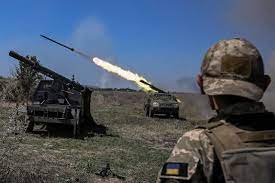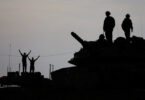Max Boot
Some US military officials appear astonished that the Ukrainian counteroffensive has not made a rapid breakthrough – and, through anonymous quotes to the news media, they are laying the blame on the Ukrainian military. Retired US Army Brig. Gen. Mark Arnold, by contrast, isn’t the least bit surprised at the slow pace of the advance – and he’s blaming the Americans, not the Ukrainians.
Arnold, a cheerful former Special Forces officer with three combat tours in Iraq and Afghanistan, has spent extensive time near the front lines advising the Ukrainian military (at his own expense). He has come away impressed by the professionalism and élan of the Ukrainian army – while also cognizant of the limitations of the training and equipment they have been provided by the West. I first met Arnold in Kyiv in May. Even back then – weeks before the start of the Ukrainian counteroffensive – he was telling me that the Ukrainians would not be able to make a breakthrough this year. However, he was – and remains – more optimistic about the prospects for decisive operations next year.
After getting back from Kyiv, I have kept in touch with Arnold and have found him a consistent font of realism. Back on June 23, at the very start of the counteroffensive, he emailed me: “I remain very skeptical that a decisive battle will occur this year that makes a material effect toward Ukrainian victory. That can happen next summer when the majority of maneuver equipment arrives from NATO into Ukraine.” More recently, he has lamented to me: “The Ukrainians lack the mobility equipment necessary to breach high-density minefields and obstacles. US Army mechanized infantry and armor battalions have tanks with antitank mine blades and heavy rollers in each company team. The Ukrainians do not.” It is not just mine-clearing equipment that the Ukrainians are short of. Last week, Arnold emailed me: “If you add all the Bradley Fighting Vehicles, Leopard 2 and Challenger 2 tanks, and other equipment, the Ukrainians could outfit only one brigade. Only six battalions of the ~350 battalions in the ground forces have been trained in combined arms by NATO.” That simply is not enough, he said, “to move the needle.”
The Ukrainian attackers are further hindered because they lack, as he noted, air superiority. In many instances, Russian attack helicopters have targeted Ukrainian armored units as they were trying to clear minefields, slowing their advance to a crawl. While some in the United States criticize Kyiv’s conduct of the counteroffensive – which appears to finally be gaining some momentum as the Ukrainians breach the first line of Russian defenses in the south – Arnold does not. “The US military would be hard-pressed to achieve much better results without air dominance and long-range artillery systems,” he told me. “So, I am pleased with the progress the Ukrainians have demonstrated to date.” Arnold rejects many of the specific criticisms being made by the Pentagon, including the charge that the Ukrainians have diverted too many resources to Bakhmut in the east. He argues that the offensive there “has not consumed large volumes of mechanized equipment” and that “Ukrainian operations in multiple geographic areas are essential to tying down Russian military resources and defending Ukrainian ground in the northeast.”
While some in the Pentagon apparently want the Ukrainians to risk heavy casualties by charging straight into the teeth of Russian defenses, Arnold believes Ukrainian commanders have made the right choice to proceed more cautiously. “Prudently valuing and expending human resources during the counteroffensive while also waiting for the majority of armor and mechanized equipment to arrive next year is wise,” he told me. Arnold’s argument – that Kyiv can achieve even greater gains next year – runs counter to the assumption among some US officials that it’s 2023 or bust for the Ukrainian advance. “We built up this mountain of steel for the counteroffensive. We can’t do that again,” one former US official told the Wall Street Journal. “It doesn’t exist.” But is that really true? The West is ramping up production of ammunition: The US Army expects that its output of 155mm artillery shells will increase from 24,000 a month this year to at least 80,000 a month next year. At that time, the Ukrainians should also have M-1 tanks and F-16 fighter aircraft. Moreover, the Ukrainian troops who have taken part in this counteroffensive – and survived – will emerge much more experienced and adept at offensive operations.
Of course, the Russians will have an opportunity to rebuild their defenses over the winter, but, by advancing further south, the Ukrainians can bring more of the Russian supply lines in Crimea and southern Ukraine within range of the High Mobility Artillery Rocket System, commonly known as HIMARS, impeding Russian efforts to restock over the winter. Arnold is optimistic that the Ukrainians can break through next year – provided they get more training and equipment than they received this year. “If the Biden administration is interested in ending this war,” he told me, “then it will provide the long-range weapons (Army Tactical Missile System, Harpoon anti-ship missiles, Reaper drones, F-16s), more M113 armored personnel carriers, Bradley Fighting Vehicles and Abrams tanks.” But it’s not just a question of more weapons. The Ukrainian military also needs more training. “The Western training of Ukrainian military during the past 15 months is 85 percent basic training, 5 percent small unit leader training and 10 percent battalion training,” Arnold says. “Those efforts have trained less than 5 percent of Ukraine’s ground forces, and almost no officers at battalion level and above.” The results of that inexperience were evident in the faltering pace of the initial counteroffensive. Arnold has been lobbying the Ukrainian General Staff and the Defense Ministry to recruit retired Western officers to train brigades inside Ukraine rather than making them go to other countries, because this will enable more units to be trained more quickly. He believes it is also essential to train corps-level staff in higher-level command functions so they can more effectively maneuver these units in combat. While retired Western officers would initially lead the training, they would be “training the trainers” so that Ukrainians could take over the courses themselves. Arnold is also trying to raise private-sector funds to expand the training and equipping of combat medics so that Ukrainian troops will be more likely to survive their wounds in combat.
“I find it frustrating, and the Ukrainians find it excruciating, that the West has the ability to do so much more to help end the war, but we’re not doing it,” Arnold told me. That needs to change. Rather than fall prey to the US military’s “short war obsession” – imagining that every war will end quickly – the Biden administration would be well-advised to set up the Ukrainians for greater success in the future even if they aren’t able to achieve all of their objectives during this counteroffensive.
The Washington Post







